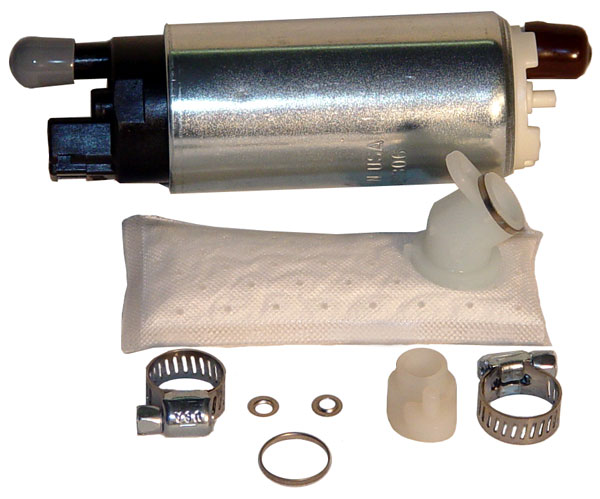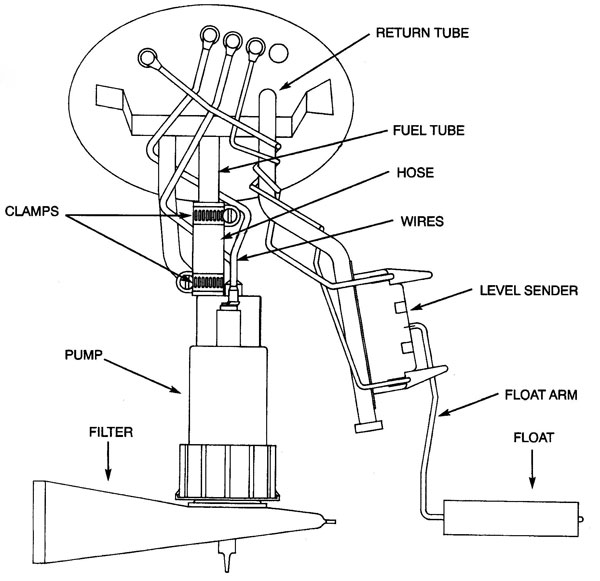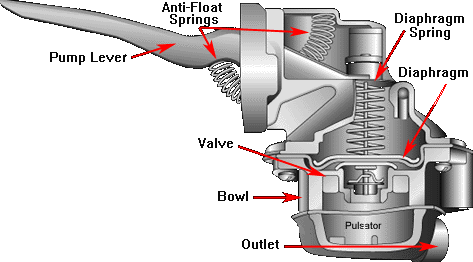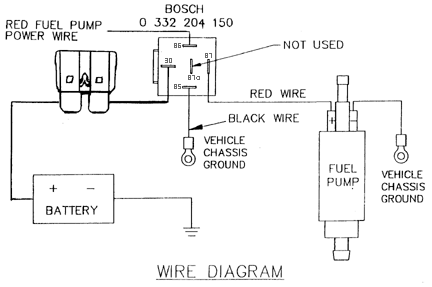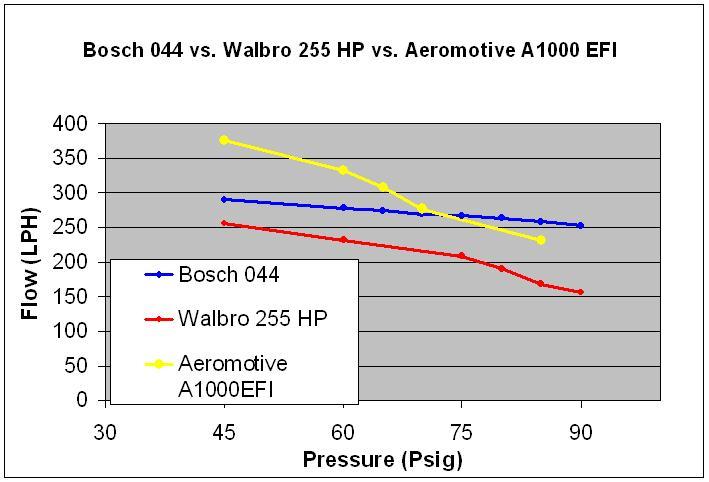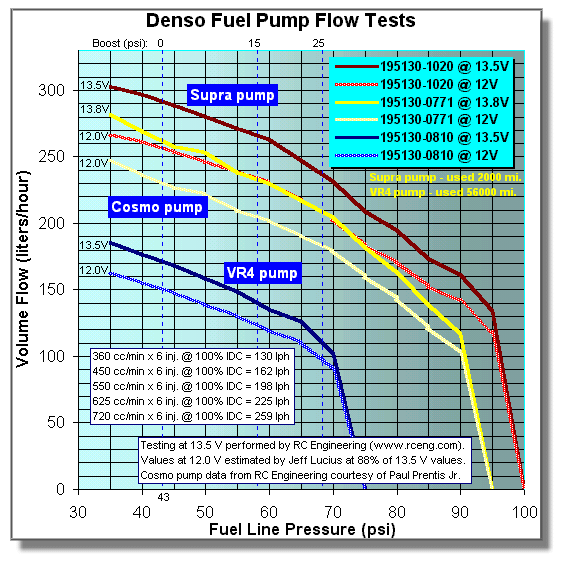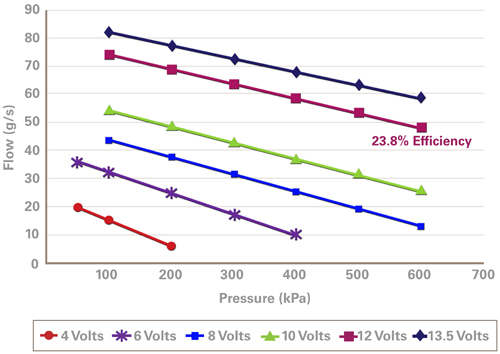| What's Hot! | Products/ Tools | EFI Tuning | Basic Tuning | Advanced Tuning | Chassis Tuning | Advertise with us |
Fuel Pumps, How they work and What to buy
Also how to size a pump based on LPH and interpret pump flow charts
Contributed by: Enginebasics.com
What to look for in a fuel pump?
Fuel pumps are the heart of any automotive system, and I mean that literally. They are what circulate the flow of fuel to and from the motor. Without them, it would be like trying to live without a heart….you don’t survive long, and neither will your motor. Every manufacturer using a fuel pump whether its Ford, Chevy, Mitsubishi, Honda, Acura, Lexus, Toyota, Lotus, Jaguar, Nissan........ I think you get the idea.
Fuel pumps come in two main forms:
1. Mechanical
2. Electronic
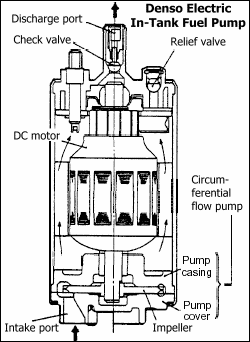
Mechanical Fuel Pumps
With the movement of modern engineering and more fuel-efficient vehicles, most have moved to using electronic fuel pumps in EFI applications. For those still using mechanical pumps let me just say that they are wonderfully simple. Basically they are mechanically driven off some part of the motor, usually the crankshaft. A lever off the crankshaft moves the diaphragm of the pump up and down pumping in fuel. Mechanical pumps are great for low-pressure applications.
Electric Fuel Pumps
Electric fuel pumps you will find on both new EFI engine applications and Carbureted motors. Electric fuel pumps offer you the ability to pump the fuel pump anywhere in the system, and are more efficient. Electronic fuel pumps can also operate at a much higher pressure than a standard mechanical pump. They are easy to hook up as they have a ( + ) and ( - ) side. Feed the negative side is grounded to the frame and the + side receives the voltage. Remember that it is best to hook up the fuel pump through a electrical relay so that you can feed the fuel pump a fresh 12v off of the battery. Then use the relay to control when the pump turns on and off. On a modern car, the relay will then be connected to the ECU which will have a pin output to control the fuel pump relay. Be sure to check the factory service manual to wire in a fuel pump relay properly. (click for larger image)
Fuel Pump Types
There are two types of pumps to now look at:
1. High Volume Low Pressure (HVLP pump)
2. High Volume High Pressure (HVHP pump)
Both come in handy depending upon the situation. What the pumps do is exactly as the name implies. A HVLP pump offers a lot of volume and flow while under very low pressure conditions. Meanwhile, a HVHP pump must operate at a very high pressure to offer the same volume as a HVLP pump.
So what fuel pump is right for your application?
A HVLP pump is great when you are providing fuel to another auxiliary fuel tank or to a surge tank. The reason being that you are not looking to have a pressurized set-up with a fuel pressure regulator or anything, you’re just looking to move fuel into another area. Think of it like a sump pump. The goal of a sump pump in your basement is to move as much water as you can even though the set-up is not under pressure, because you are just pumping it out the other side. It is true with the HVLP pumps as well. It’s all about moving tons of volume into another container at low pressures.
A HVHP pump will move a high volume of fuel just like a HVLP pump, but it will flow even at high pressures. Most fuel pumps flow is inversely proportional to fuel pressure, meaning as the fuel pressure goes up, the fuel pump flows less. This is why it’s important to purchase a fuel pump that is meant for high pressure situations. To use a HVLP pump in a high-pressure situation, which would be a total no no, you will notice that the pump flows almost nothing at all as the pressure climbs higher than the pumps intended range.
Finding a pump that meets my needs
A fuel pumps flow is rated with two units:
1. The volume it flows
2. The pressure it flows that volume at.
It is important to pay attention to both of these numbers, and even better, look for a volume vs pressure chart for that particular fuel pump. For example:
One company might advertise a pump that flows 255LPH, meaning 255 liters per hour, but this means nothing unless you know what pressure that pump flows that pressure at. It is says it flows 255 LPH @ 40 PSI, and you see another pump rated at 255 LPH @ 50 PSI, many might think they offer the same flow. The reality is that while they CAN offer the same amount of flow, both pumps need to be compared at the same absolute pressure. I would suspect that a pump rated at 255 LPH @ 40 psi would only be flowing around 210 LPH at 50 PSI.
So what else should I know?
One last thing to know about fuel pumps when you look at their ratings of flow, is at what voltage the pump was run at during the test. A pump rated at 255 LPH @ 40 psi @ 12 v will flow even more at a higher voltage. At say 14 v, the same pump might flow 270 LPH @ 40 PSI. Take it even further to lets say 17v and now the same pump will flow almost 300 LPH @ 40 PSI.
So how do you change the voltage to your pump? You will need a device like the Kenne Bell Boost a Pump. These are devices that can up the voltage to a fuel pump either all the time, or based on a certain boost pressure if you hook up the optional Hobbs Switch. This is a great option for someone that is looking to get just a little more flow out of a pump without to much modification or installing a whole new, and larger pump.
Summary:
1. Ask yourself if you need a high pressure or low pressure pump.
2. Look at how many liters per hour of flow you will need to support your engine
3. Look at the pressure ratings of those pumps at the desired fuel pressure range you will be running in ( remember it changes based on the fuel pressure regulator)
4. Look at the voltage you will run the pump at and its flow at that supplied voltage.
5. Use a trusted brand pump. This is not the time to save money. When a fuel pump dies the motor can lean out and Boom, thousands of dollars lost. Pay a little more now and save later. We here at enginebasics.com have had great success with the following fuel pumps:
First the Bosch 044. This thing is a work horse and known in the industry for its reliability in all conditions with all fuels.
Next up is the highest flowing drop in fuel filter on the market that is ethanol rated and quiet for the amount of fuel it flows. And the price....it's hard to believe its a 450 lph pump:
If you don't require as much fuel as the walbro 485, then we suggest the tried and true Wabro 255 high flow. They have both an in-tank and external:
and external
ATTENTION READER:
If you enjoyed the information and article you just read be sure to check out our newly released book with even more exciting photo's and information:How to Turbocharge and Tune your Engine

Want to know more about your particular Make and Model vehicle? All of these vehicles are covered in the tech, maintenance and repair articles found above. Enginebasics is the wiki or wikipedia of car part, repair, how to and tuning information. Let us be the class 101 for your automotive learning.
| Ford | General Motors GM | Pontiac | Jaguar | Land Rover | Nissan |
| Toyota | Honda | Lexus | Acura | Lotus | Scion |
| Infinity | BMW | Mercedes | Mitsubishi | Ferrari | Maserati |
| Lamborghini | Volks Wagen VW | Saab | Audi | Hyundai | Kia |
| Subaru | Mazda | Chevy | Volvo | Caddilac | Dodge |
| Chrylser | Daewoo | Porsche | Mercury | Freightliner | MG |
Individual Models
| Ford Mustang | Mitsubishi Eclipse | Mitsubishi Evo | Subaru WRX / STI | Dodge Viper | Chevrolet Corvette |
| Nissan Skyline | Honda S2000 | Nissan 350z | Toyota Supra | Chevy Camaro | Lotus Elise Exige |
| Honda Civic | VW Golf | Dodge SRT-4 | Eagle Talon | Acura Integra | BMW M3 |
| Nissan 240sx | Porsche 911 | Acura NSX | Honda Accord | Toyota Camry | Toyota MR2 |
| VW R32 | Dodge Truck | Mazda Rx7 | VW Jetta | Sand Buggy | Nissan Sentra |
For the latest Automotive news and stories visit the websites below |
Our feature Build: An AWD V6 Civic



